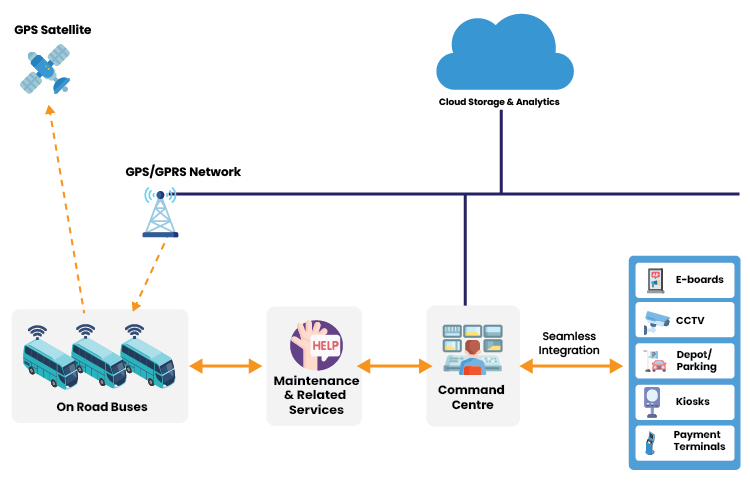

ACL Digital
5 Minutes read
Achieve Sustainability with Smart Fleet Management
As global awareness related to environmental issues continuously increases, sustainability has been the top of all for all the industries serving different domains. Sustainable fleet management helps to achieve the sustainable growth of the company by setting high goals, saving a good amount on cost and also minimizing environmental effects. Nowadays, companies are moving towards adopting or practicing cutting-edge technologies like telematics, AI-based predictive maintenance, and IoT-enabled tire monitoring. This will approach numerous benefits, including maximizing fuel efficiency, adding more lifespan of vehicles and increasing overall fleet performance. This blog focuses on essential strategies for sustainable fleet management, by showing the architecture of it and how a sustainable fleet can be achieved.
Key Strategies for Sustainable Fleet Management
Sustainability can be achieved through the following are the essential strategies that focus attention on how intelligent solutions improve fleet efficiency:
Switching to Alternative Fuels
To significantly reduce the carbon footprint of the fleet, one of the most effective ways is to adopt alternative fuels. Few options could be electric vehicles (EVs), hybrid vehicles, compressed natural gas (CNG) and biodiesel. Each alternative carries different benefits, but particularly EVs are attracting attention due to headway in battery technology and charging infrastructure. Companies can significantly cut greenhouse gas emissions and reduce reliance on fossil fuels by taking these vehicles into their fleets.
Fuel-Efficient Driving Training
Different better driving techniques taught by the driver teaching school can make a huge difference in saving fuel. Maintaining a steady speed, avoiding unnecessary idling, and accelerating smoothly help to substantial saving in fuel costs and emission. Real-time feedback incorporated with regular training from smart tracking systems helps drivers to stay more methodical and encourage industry committed to sustainability.
Fleet Right-Sizing
Reviewing the size and composition of the fleet is necessary for sustainability. The process of determining the number and types of vehicles in the fleet that satisfy operating needs is called “right-sizing. Businesses may cut down expenses and pollution by getting rid of unwanted cars and selecting more improved models. This strategy works to boost productivity and aligns fleet operations to achieve sustainability goals.
Telematics System Installation
Real-time data on vehicles and driver actions helps to optimize routes, minimize idle time and enhance fuel efficiency. These contribute to cost reduction and a lower carbon footprint, supporting more sustainable fleet operations. Analyzing these data allows fleet managers to implement result oriented sustainability strategies.
Regular Maintenance and Inspections
It is essential for sustainability and safety to keep vehicles in their best condition. Regular inspection of vehicles determines many issues that cause tire pressure and engine performance, fuel efficiency. A well-planned vehicle maintenance takes care of vehicles to run smoothly, decrease repair costs and reduce environmental impact.
Integrating Sustainable Energy Sources
Fleet performance can be improvised with having electric vehicle charging stations with renewable energy sources like solar and wind energy. With the help of using renewable energy to run charging stations, companies can eventually reduce their carbon footprint and project a more green image.
Sustainable Fleet Management Architecture

Process of Achieving Sustainability in Fleet Management
The balance between operational efficiency, cost savings and environmental responsibility are the key strategies for sustainable fleet management. The following steps are the process that highlights how companies can create a more sustainable and efficient fleet:
Assess and Optimize Fleet Operations
Increasing operational effectiveness can have big advantages instead of always solely relying on new vehicle purchase. GPS tracking and telematics implement real-time monitoring to refine routes, reduce idling and promote efficient driving behavior. The combination of deliveries and trips helps to reduce fuel consumption and vehicle durability results in minimizing maintenance costs, and reduces environmental impact.
Maintain Vehicles for Maximum Efficiency
Regular maintenance helps to enhance overall performance of vehicles, fuel economy, and emission reduction. There are two aspects of tire care namely alignment and inflation that helps to expand tire life and improve fuel economy.
Utilize Telematics & Smart Fleet Solutions
For proactive maintenance, real-time tracking checks and assists with tire pressure, engine condition, and diagnostics. Telematics also provides awareness of driver behavior, such as harsh braking and sudden acceleration, to improve fuel efficiency. GPS tracking offers multiple benefits, including helping to avoid traffic, saving fuel, and conserving gasoline. Managing vehicles efficiently reduces strain on specific assets, extending their service life and minimizing the need for replacements.
Encourage Eco-Friendly Driving Practices
Increasing vehicle lifespan and fuel efficiency is mandatory and it could be achieved by a smooth acceleration and braking system. The feature like cruise control helps to maintain steady speed and minimizes unnecessary fuel burn. Shutting off engines when they are motionless for a prolonged period of time helps to reduce emission. Telemetrics-driven feedback, continuous driver training and incentives encourage drivers to drive more fuel-efficiently.
Develop a Long-Term Sustainability Strategy
Benchmark for fuel economy and emission reduction targets, Setting measurable objectives gives sustainability initiative. Long-term fleet efficiency can be achieved with shifting from fuel-inefficient models to hybrid or electric vehicles. With Fleet management software, it is possible to track real-time tracking of sustainability progress, operations and regulatory compliance. Continuous changes in sustainability strategies with the changes in technology and policy updation, promotes long-term success.
ACL Digital's Role in Developing Smart Fleet Management Solution
At ACL Digital, we have helped clients by developing smart tire monitoring solutions to enhance fleet efficiency, reduce operational costs, and achieve sustainability goals. By leveraging AWS cloud connectivity and advanced sensor integration, the client gained real-time insights into vehicle health, enabling proactive maintenance, optimized fuel consumption, and improved route planning. The solution resulted in lower emissions, reduced downtime, and increased overall fleet reliability, ultimately driving better business performance and environmental responsibility.
Case Study: AWS Cloud-Connected Wheel and Fleet Management Solution
Client Overview
Our client is a leading US-based technology company offering solutions for the transportation industry. They sought a reliable engineering partner to develop a cloud-connected fleet tire monitoring solution, providing real-time alerts to drivers and logistics companies about tire health and performance, ensuring seamless and efficient logistics operations.
Challenges
- Reduce fuel consumption
- Lower maintenance costs
- Enable real-time alerts for tire health and performance analysis
Our Approach
- Developed a real-time Tire Pressure Monitoring System (TPMS) leveraging AWS Cloud for seamless connectivity and instant alerts
- Integrated IoT sensors to monitor tire pressure, weight, and brake pad health in real-time
- Enabled cloud-based data analytics for predictive maintenance, reducing unexpected breakdowns and optimizing fleet performance
- Provided a driver and fleet management dashboard with intuitive insights for proactive decision-making
Benefits Delivered
- Reduction in fuel consumption with optimized tire performance monitoring
- Decrease in maintenance costs due to real-time health monitoring of tires and brake pads
- Enhanced fleet safety and efficiency with proactive issue detection and automated alerts
Want to learn how real-time fleet monitoring can transform your logistics operations? Download the Full Case Study Here!




